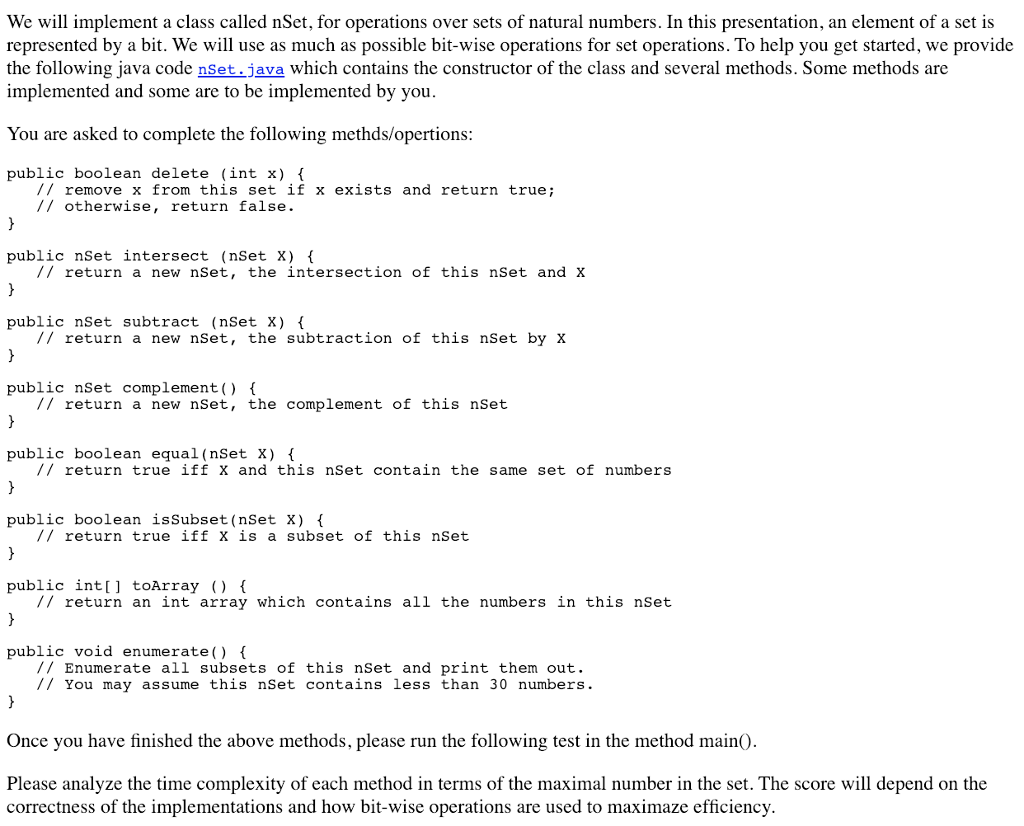Answered step by step
Verified Expert Solution
Question
1 Approved Answer
Computer Algorithms HW We will implement a class called nSet, for operations over sets of natural numbers. The following is Java code is required to
Computer Algorithms HW "We will implement a class called nSet, for operations over sets of natural numbers."  The following is Java code is required to solve and is from the link nSet.java:
The following is Java code is required to solve and is from the link nSet.java:
import java.util.ArrayList; import java.util.Collection; import java.util.List; import static java.lang.Integer.max; import static java.lang.Integer.min; /** * For complexity analysis, let m be this.max and n be the number of elements in this set. */ public class nSet { // this class implements the set operations over sets of natural numbers. public int Max; // maximal natural number in any set private int n_long; // the number of long integers: 64*n_long > Max private long[] store; // the store has n_long longs private int size; // remember the size of the current set // Constructor: runtime = O(m), with a small constant less than 1 public nSet(int n) { this.Max = n; if (n > 6) + 1; // n_long = n/64+1, number of longs this.store = new long[n_long]; for (int i = 0; i this.Max) return; int i = (x>>6); // i = x/64 int j = x - (i>j) & 1) == 1) return; // if x is present, do nothing this.store[i] |= ((long) 1>6); // i = x/64 int j = x - (i>j) & 1) == 1; // "&" is the bitwise OR operation } //O(m) runtime, with a small constant less than 1 public void clear () { for(int i = 0; i>j) & 1) == 1) counter++; } } this.size = counter; } // Constant runtime public void print () { // print up to 30 numbers in the current nSet System.out.print("{ "); int count = 0; for(int i=0; i> j) & 1) == 1) { System.out.print(((i = 30) { System.out.println("... }"); return; } } System.out.println("}"); } // O(m) runtime public nSet union (nSet X) { int maximum = max(this.Max, X.Max); nSet A = new nSet(maximum); for(int i=0 ;i Thank you for your help.
We will implement a class called nSet, for operations over sets of natural numbers. In this presentation, an element of a set is represented by a bit. We will use as much as possible bit-wise operations for set operations. To help you get started, we provide the following java code nSet.java which contains the constructor of the class and several methods. Some methods are implemented and some are to be implemented by you You are asked to complete the following methds/opertions: public boolean delete (int x) f // remove x from this set if x exists and return true; // otherwise, return false. public nSet intersect (nSet X) { // return a new nSet, the intersection of this nSet and X public nSet subtract (nSet X) I // return a new nSet, the subtraction of this nSet by X public nSet complement() // return a new nSet, the complement of this nSet public boolean equal(nSet X) { // return true iff X and this nSet contain the same set of numbers public boolean isSubset (nSet X) f // return true iff X is a subset of this nSet public int[ toArray ) // return an int array which contains all the numbers in this nSet public void enumerate() { // Enumerate all subsets of this nSet and print them out. // You may assume this nSet contains less than 30 numbers Once you have finished the above methods, please run the following test in the method mainO Please analyze the time complexity of each method in terms of the maximal number in the set. The score will depend on the correctness of the implementations and how bit-wise operations are used to maximaze efficiency Step by Step Solution
There are 3 Steps involved in it
Step: 1

Get Instant Access to Expert-Tailored Solutions
See step-by-step solutions with expert insights and AI powered tools for academic success
Step: 2

Step: 3

Ace Your Homework with AI
Get the answers you need in no time with our AI-driven, step-by-step assistance
Get Started


